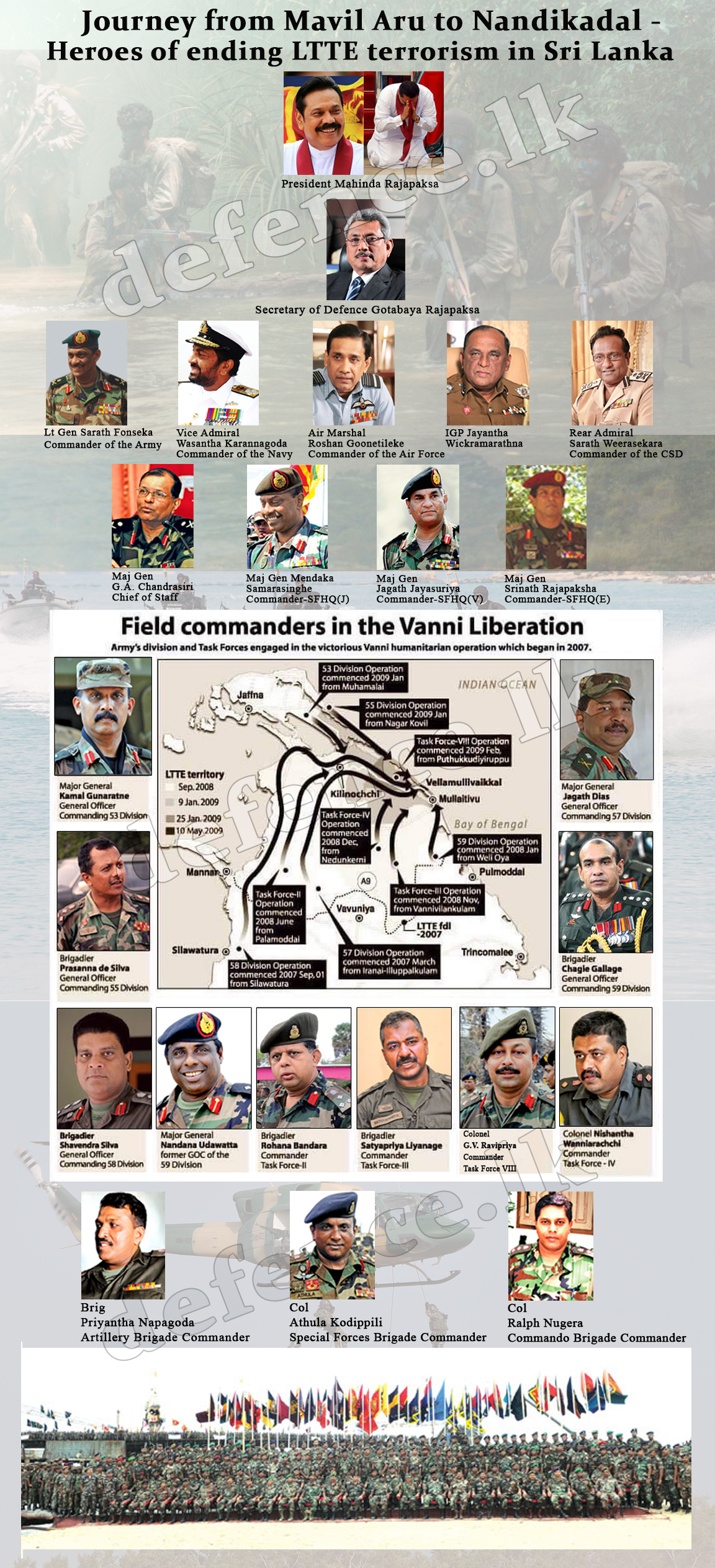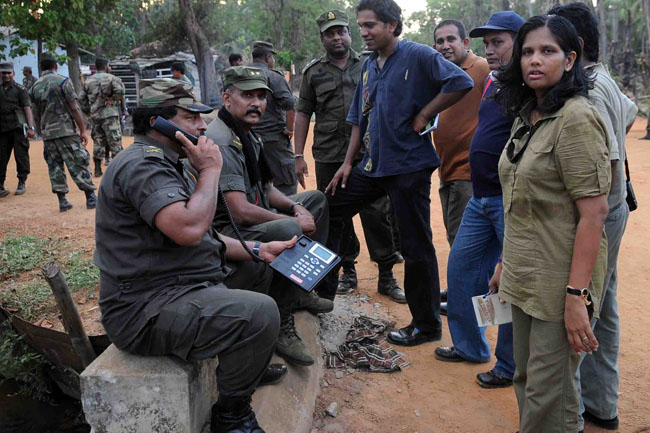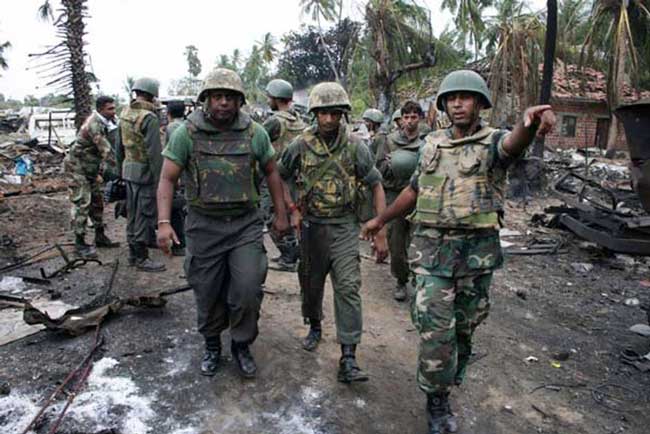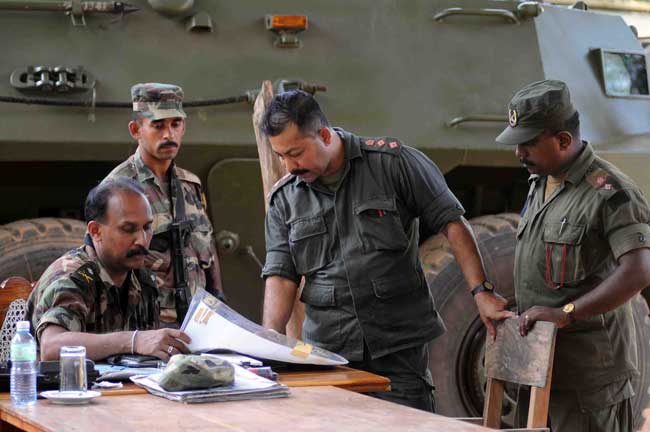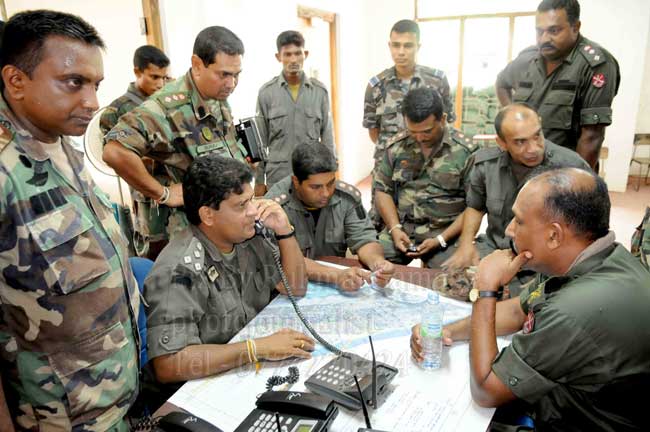The final 48-hours of end battle
May 19, 2020From a reporter’s diary:

Leaders of the Wanni humanitarian operations
By Shanika Sriyananda
Pix by Rukmal Gamage
Yesterday, I was taking notes to include in the National War Heroes Commemoration Day message of Defence Secretary Maj.Gen. (Retd) Kamal Gunaratne, a decorated soldier who was credited for leading his 53 Division troops to capture the most wanted terrorist – Vellupillai Prabhakaran, who played with thousands of innocent lives of all ethnicities.
“The Government, under the leadership of President Gotabaya Rajapaksa, would not allow any force to become a threat to the national security. We will ensure by all means that lasting peace will prevail in Sri Lanka for our future generation to enjoy dividends of hard earned peace through immense sacrifices made by our war heroes,” he asked this to be included in his message released today.
This took me to May 19, 2009 how this war veteran and all other Division Commanders of the Sri Lanka Army were jubilant and walked majestically on the banks of Nandikadal announcing the end of 30-years of terror with finding the body of the LTTE leader Prabhakaran.
Eleven years ago, on May 19 around 10.05 am I was at the banks of infamous Nandikadal lagoon, in Vellimullivaikkal, where thousands of soldiers jubilantly flocked to witness the most exciting moment in their lives.
His body, with no cyanide capsule hung around his neck, was lying on a patch of mud-soaked grass on the lagoon bank.
I wrote in my article on Prabhakaran’s death to Sunday Observer : “ At 10.05 this morning , Tuesday 19, the monster, who created thousands and thousands of grave yards, has dug his own grave.
When Sri Lanka is celebrating the National War Heroes Commemoration Day in a low key due to coronavirus threat, today, I recalled the stories that I have penned down based on my experiences as a journalist who covered the war since liberating Thoppigala in the East to the last days of the war in Puthumathalan and Vellimullivaikkal during the final phase of the Eelam War IV, 11-years ago.
It was a battle that many had declared annihilating the LTTE was impossible but it turned to be a possible task under the correct and visionary political leadership combined with excellent military capabilities of officials who knew the art of fighting a war.
I found articles I had written during the last battle in May 2009, which were published in a weekend paper, where I worked then.
Following is the excerpts of an account written to the Daily Financial Times based on my experiences covering the final days of the end battle when I was reporting to the Sunday Observer in May 2009.
“Those were precious for any journalist who can recall the plight of the innocent civilians fleeing for life in terror and also the victorious moment which announced the end of the many years of bloodshed when the body of the Liberation Tigers of Tamil Eelam (LTTE) leader was found”.
18 May 2009 – mass exodus of fleeing civilians
The very sight of it was sickening; very moving to a point of wanting to get lost from it all. I closed my eyes trying to repress tears.

The baby girl was holding her mother’s hand and crying in pain. The body was bathed in blood, but the little girl oblivious to the fact still held her mother’s cold hand trying to wake her up. But the pregnant woman was dead, the bullet ripping through her womb killing the baby inside. Flesh was strewn all around, and the head of the fetus had come out when the bullet pierced through the woman’s belly. A travelling bag with tiny baby shirts and a milk bottle lay near the body. The small girl, covered with mud, was screaming ‘amma ... amma... elumbunga...’ (Mother get up... get up).
The young woman, whose husband was killed by the LTTE when he was trying to flee with the family, had escaped with thousands of others when the troops of 58 Division broke through the LTTE’s last earth bund at Ampalavanpokkanei in the No Fire Zone. Carrying her little daughter, she too had crossed the lagoon. But a few minutes before her ‘journey to freedom’, she was felled by the LTTE’s Eelam police that started shooting indiscriminately at the fleeing civilians.
The image of her body with the blood-soaked foetus propped up still haunts me and those traumatic scenes reside deep within my memory.Untitled-1
It was noon on 18 May 2009, when thousands of civilians who were kept as human shields by the LTTE were fleeing from the north of the No Fire Zone (NFZ) in Puthumathalan.

We were heading towards the NFZ in Puthumathalan, which was captured that morning. Walking through a ‘human river’ was not that easy. Interviewed one ... two... 10 and more. The stories were the same. They were herded from place to place by the LTTE and their lives were reduced to zero.
Overcoming the first barricade – communication – thanks to Tamil-speaking soldiers, I managed to jot down their agony with shaking hands and tears streaming down my face. How could a human being hide tears in front of a tiny tot screaming in hunger... an old man screaming in pain with a gunshot injury... a mother screaming in front of her son’s dead body.
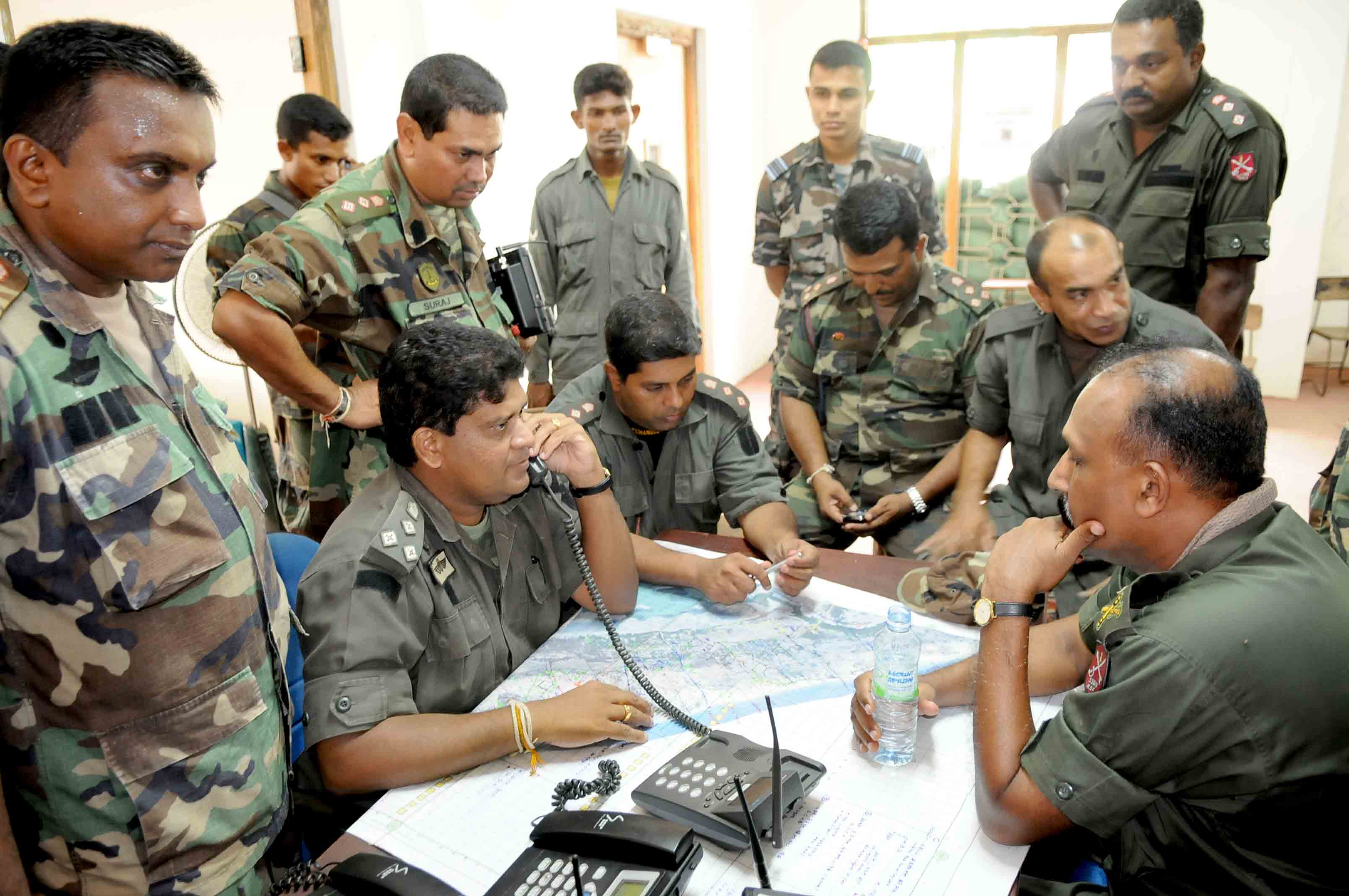
It was something which any human being should not have to experience. I was speechless when these people were pleading for just a few drops of water or a tiny piece of biscuit.
I met 30-year-old Chandrakumari Balasingham, who was shot by the LTTE when she was fleeing. A nurse of the Puthumathalan Hospital, she was compelled to work and could not flee earlier due to threats. A young soldier who found her with severe head and leg injuries brought her to safety. She pleaded with the soldiers to save the life of her mother, who also couldn’t move due to gunshot injuries.
We proceeded further, sometimes running along the trenches and taking cover to hide ourselves from the still-active LTTE snipers. Personal documents, IDs issued by the LTTE, slippers and clothes were strewn along the road. We crossed the huge earth bund which the LTTE had built to prevent troops coming in.
Purugei Sellathi, an 80-year-old mother, who couldn’t leave the NFZ as she couldn’t carry her 48-year-old disabled son, was feeding him rice given by the soldiers. “I had two sons. The LTTE killed their families. The LTTE left us to starve and die,” she said, then threw some sand and cursed the LTTE.
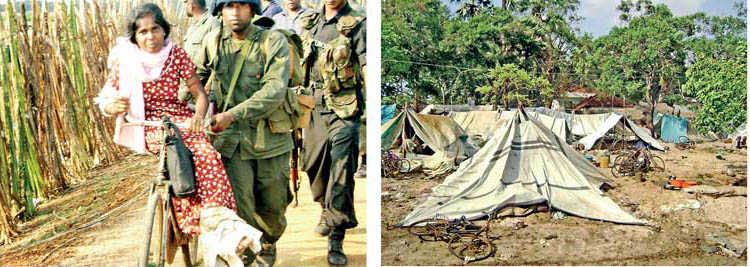 It was a game of the fittest. The civilians who were strong enough to carry a member of their families fled with them. But the old and the sick, mostly the parents, were left in the Puthumathalan Hospital. The soldiers in their humanitarian operation rescued them.
It was a game of the fittest. The civilians who were strong enough to carry a member of their families fled with them. But the old and the sick, mostly the parents, were left in the Puthumathalan Hospital. The soldiers in their humanitarian operation rescued them.
The northern part of NFZ, where the LTTE kept some 104,275 civilians, was hell. Tents were erected in every tiny space and these civilians were compelled to live like slaves. Civilians lived in small huts along the Puthumathalan beach. Recent rain water had made small pools around the huts and people were living in huts filled with water. Some had converted vehicles into makeshift adobes. The awful smell emanating from the strewn dead bodies as well as carcasses of animals polluted the air.
A large number of cyanide vials too were strewn in the NFZ, indicating that the LTTE cadres too had fled with the civilians.
Most of the young females were pregnant or with infants. They had early marriages and when the LTTE was forcibly trying to enlist girls they got themselves pregnant in order to avoid joining the LTTE. The young men lived in bunkers to escape the LTTE.
I interviewed parents who had hidden their small and young children, who were fit enough to hold a gun, to avoid the LTTE Police snatching them for the final battle.
Some cursed the LTTE leaders who travelled in black bullet proof luxury vehicles with their escorts, plying the crowded roads of NFZs with no mercy for the civilians who were being herded by the terrorists as the soldiers were entering the LTTE-controlled areas.
Catholic priests and 72 orphans
By evening the last civilian, an old disabled woman fleeing LTTE-held territory, crossed the causeway of the Nandikadal lagoon. She confirmed no civilians were there in the land, from which one could see a huge fire, where the LTTE had burnt all of their vital documents including their military plans, foreign assets and information on cadres.
On the same afternoon, the key commanders of the final battle had brainstorming sessions to ensure the capture of Velupillai Prabhakaran.
By 18 May evening, all guns and energy were aimed in a single direction – the small plot of land in Puthumathalan. It was the most intense time for the troops of all divisions – 53, 57, 58, 59 and all Task Forces – who were preparing for their biggest capture. The search was on and each division sent their special teams in to sweep the land and hunt him down.
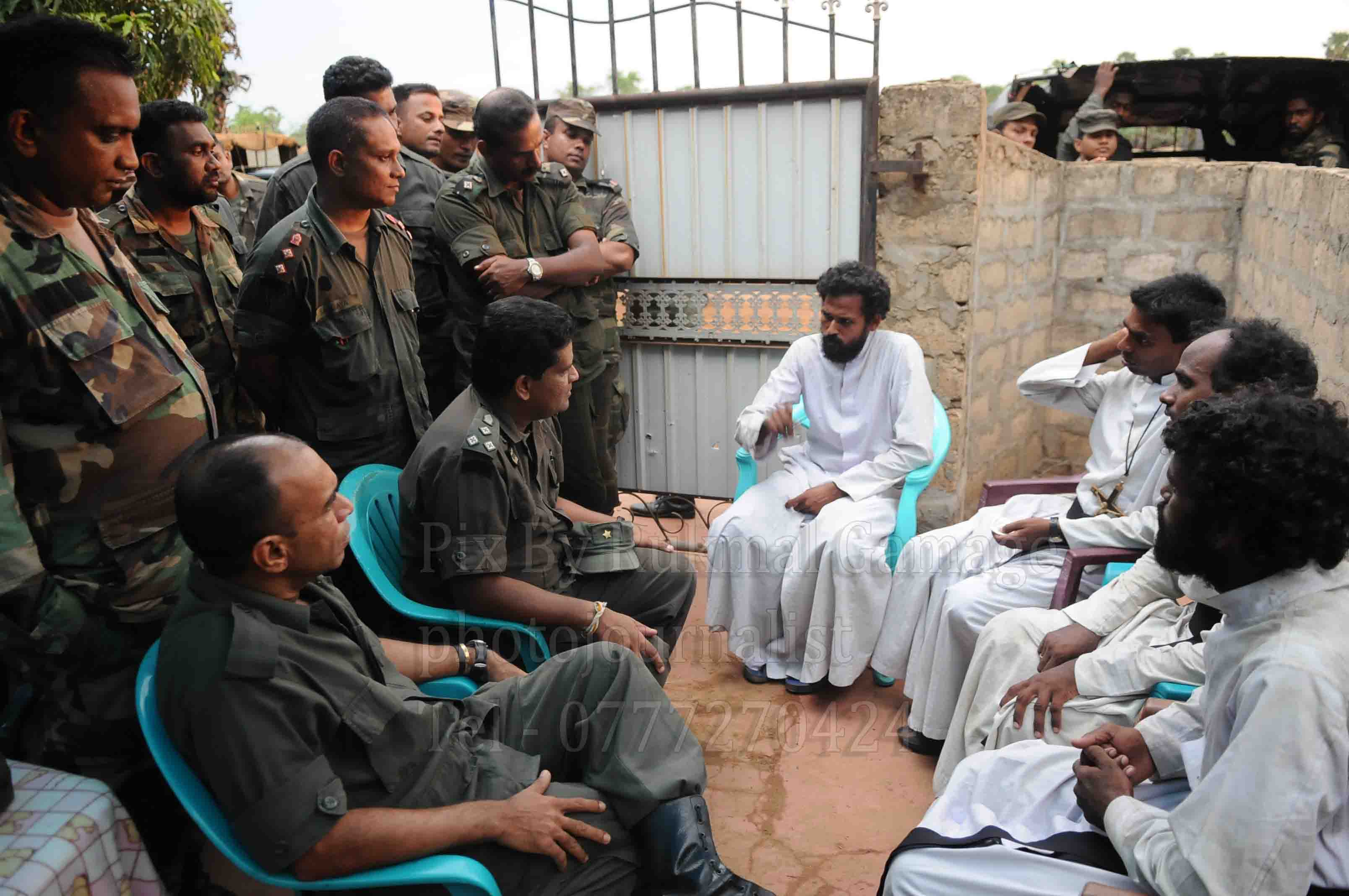
After a heavy day, filled with blood and flesh, where hostages were struggling to escape, we were at the small military base, just few hundred meters away from the NFZ.
The top military officers of all the Divisions had a quick brainstorming session to put the final touches to their military plan. Orders were given and hundreds of soldiers disappeared in the darkness. They all had one goal – to find Prabhakaran, dead or alive.
However, instructions were sent to soldiers of the 58 Division to halt firing at one portion of the NFZ as its Commander Brigadier (now Major General) Shavendra Silva had received a message from a member of the Catholic clergy requesting them to facilitate four Catholic priests with 72 orphans, the last batch of hostages fleeing the NFZ.
After a few hours, a truck full of soldiers giving protection to the four Catholic clergy brought them safely to the military base.
The tired faces mixed with shock and happiness showed the agony that they had experienced for years. The men who had devoted their lives to God, had been herded from place to place by the terrorists. With unshaven beards and overgrown hair, their white cloaks muddy, the crucifixes they wore around their necks gave them solace in the horror-filled land.
The pale faces brightened up as they were warmly welcomed and served hot short-eats – fish buns, rolls and sandwiches – made by the soldiers. That was the first time in the recent past they ate in an environment free of terror. The hot cup of tea served by a soldier refreshed them.
They informed the two Commanders – Brig. Shavendra Silva and Brig. Chagie Gallage (now Maj. Gen.) about their deadly walk through LTTE fire.Untitled-3
“We tried to escape but since we had to take care of 72 orphans we couldn’t do it so easily. We lived in bunkers,” Fr. Mariathas said, adding that one priest had died of a heart attack while they were fleeing.
Fr. Mariathas of the Jaffna Diocese was appointed to serve people in Mannar from 1 June 2008. He fled from Mannar to Vellankulam to Vannari to Puthumathalan with displaced civilians who were threatened by the LTTE to move from place to place.
They explained the plight under LTTE control. “People faced many difficulties and they starved because the LTTE had stolen their food quota. They used all inhumane tactics to hold the people. No matter how much we pleaded, the LTTE did not allow us to cross. Those who tried to flee were beaten or killed,” they said.
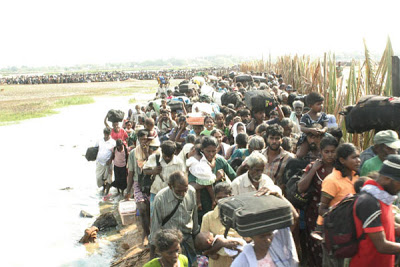 They recalled how the LTTE conscripted small children and their struggle to surrender to the soldiers amidst heavy firing by the LTTE.
They recalled how the LTTE conscripted small children and their struggle to surrender to the soldiers amidst heavy firing by the LTTE.
It was almost 9 p.m. The troops were still busy hunting the ‘most wanted’, who was believed to be somewhere in the small patch of land. While the priests and the children were transported to the welfare camp in Vavuniya, we too had concluded our day’s assignment and followed the fleet of vehicles of the two GOCs plying on the Puthukkudiyiruppu stretch of road along the Nandikadal Lagoon amidst thick darkness and thundering explosions of artillery in the NFZ.
The next morning (19 May) came the big news – the troops had killed the most wanted and found his body; we breathed a sigh of relief as we realised that we too had escaped a deadly attack by the LTTE who were hiding neck-deep in the Nandikadal Lagoon to escape to the east.
It was few hundred meters from the point where the deadly Prabhakaran and his men numbering over 150 were hiding in the small stretch of islets in the lagoon to the road that we had travelled.
May 19, 2009 – end of Prabhakaran’s saga
The sleepless night had brought us all – media colleagues – a myriad of views about the fate of Prabhakaran. One said he might have escaped to a European country via sea a few months ago. Another said he might have died of a shell attack or in a confrontation. Again one disputed it saying that he might have escaped into a welfare camp mingling with civilians or he was living in the south in disguise. Finally, we agreed with the thought that he might have used the cyanide vial, which he invented and always hung around his neck, and died to avoid the military capturing him alive.
We heard heavy shelling and firing a few km away from where we spent that night. All the division Commanders were in their military ops rooms coordinating directly with those fighting in the battlefronts. The elite Commandos and Special Forces soldiers were fighting fiercely in the surrounding areas of the Nandikadal Lagoon, where they faced confrontation from a group of terrorists while searching around the mangroves of the lagoon to find Prabhakaran – dead or alive.
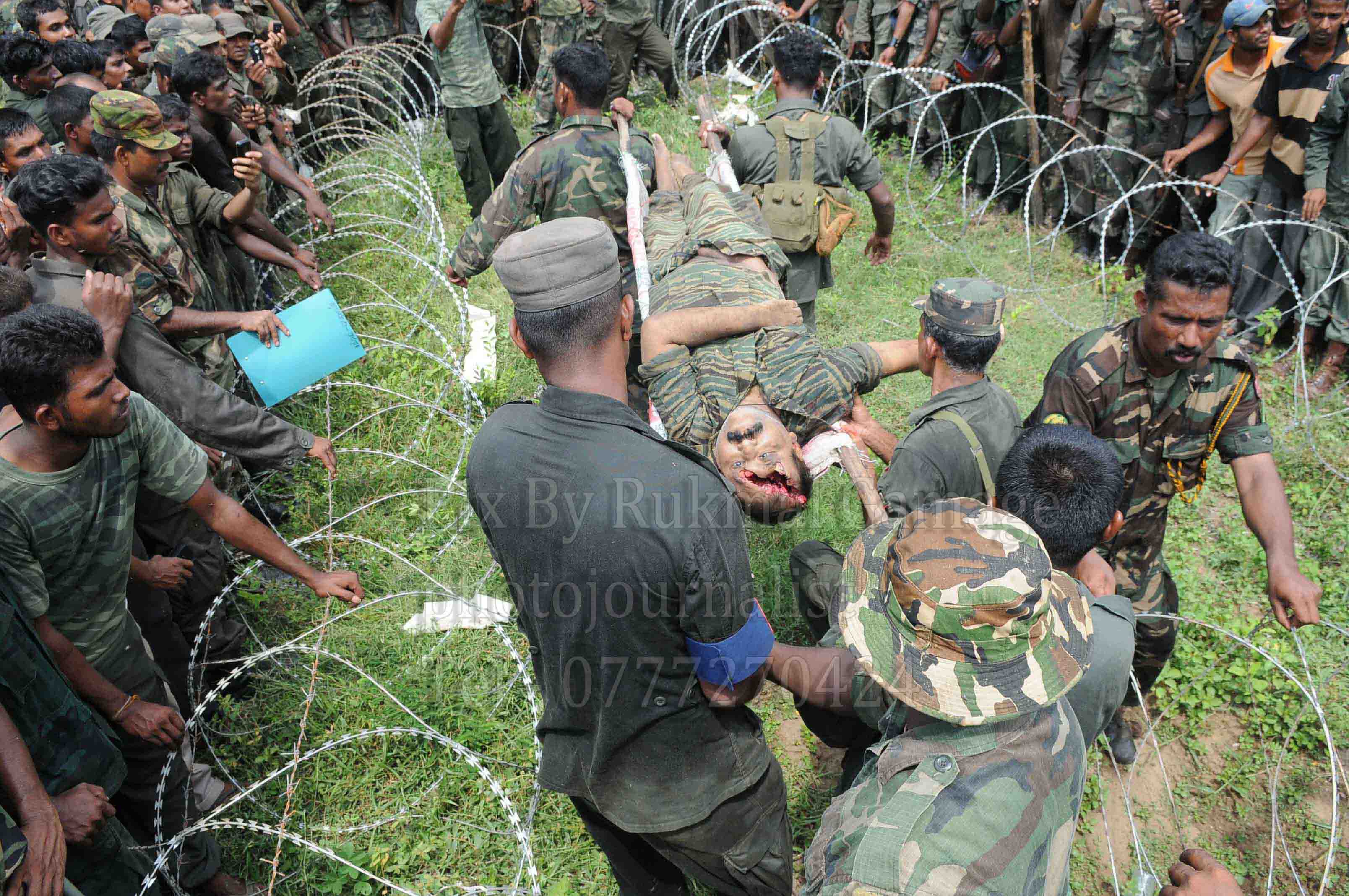
On 19 May 2009 morning we again rushed to the Nandikadal Lagoon as we were alerted by a Division Commander to be there soon.
Thousands of soldiers had flocked to the lagoon to witness the moment that Prabhakaran’s body was brought to the banks of the lagoon from the patch of muddy mangroves, where he and cadres of his close protection ring fought until a few hours ago.
When the soldiers appeared from the mangroves carrying the body of Prabhakaran, soldiers started firing at the sky in victory.
The body of the 54-year-old stocky man in Tiger-striped uniform was laid on the lagoon banks. Fresh blood kept trickling from the gaping wound in the man’s head, where a bullet had pierced through his forehead and blown off his brains. Apart from his head, his whole body was pale as he had been hiding neck deep in the lagoon for many hours.
The man, who had the control of over 15,000 square kilometres of land of Sri Lanka, had breathed his last in the mangroves that morning, which gave the first signal of the end of the war. Prabhakaran, who loved his life more than anything else, despite motivating thousands of boys and girls to blow themselves up and bite a vial of cyanide, had not done the same.
With no cyanide capsule, his dog tag TT 3 bearing the number 001 and dated 16.09.95 hung around his neck. His Eelam identity card with his picture bearing number 01543301002 issued on 01.01.2007 and with his personal details like date of birth – 26.11.1954, place of birth – Velvatiturai and occupation – Leader of the LTTE, had been found in a wallet.
The soldiers had recovered his belongings wrapped in a polythene bag. It contained a gas mask, diabetic drugs, dressings, insulin, handcuffs, two T56 rifles used by Prabhakaran, glucose, creams for wounds, and interestingly a bottle of berry scent moisturising and vitamin E cream made in Singapore.
In death, Prabhakaran’s wide-open eyes appeared to be very sharp. He had gone without a shave for days and grey hair had propped up in his thick moustache and around the chin. His fleshy stomach had shrunk indicating that he had missed many meals. The soldiers had also recovered the pistol carved with the number 001 belonging to Prabhakaran.
Prabhakaran, who was neck-deep in the lagoon water with his loyal escorts, had fought the elite Commandos and soldiers of the 4th Vijayaba Infantry Regiment since the wee hours of 19 May 2009.
When Prabhakaran’s body was laid on the lagoon banks, the Commander of the 53 Division, Maj. Gen. Kamal Gunaratne, whose soldiers killed the LTTE Leader that morning, broke the news to Army Chief Lt. General Sarath Fonseka. During the conversation we saw his face change for a moment.
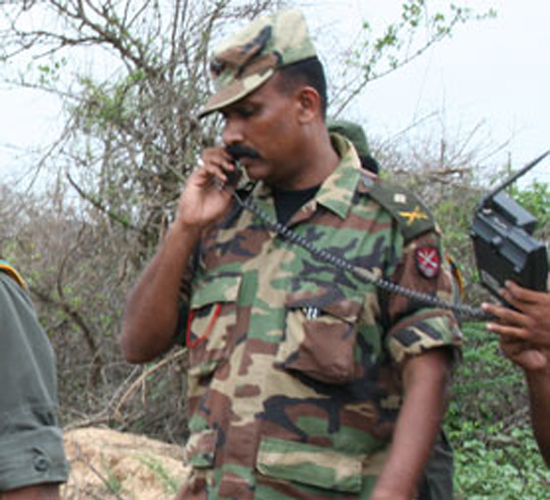
“He ordered us to remove Prabhakaran’s uniforms as terrorists can’t wear uniforms,” he said in an upset tone and instructed the officers to remove Prabhakaran’s Tiger striped uniform. That was why the LTTE leader was seen half-naked later on TV and this had stirred suspicions that he was tortured and killed. I only saw a bleeding wound on the forehead and the blown-off head from the back. He had a fair and clear skin complexion.
While many soldiers kept coming in, creeping through hundreds of colleagues flocking around the body, to catch a glimpse of the man who made them fight for over 30 years, Prabhakaran’s trustworthy bodyguard for years, former Minister of National Integration and Reconciliation Vinayagamurthi Muralitharan (Karuna Amman) and Daya Master, the LTTE’s former Media Spokesman, were flown in from Colombo to identify the body of the LTTE leader.
Prabhakaran’s fate was such that the duo saw him on the banks of the lagoon in Vellimullivaikkal only to identify the body as that of the leader of the LTTE.
“He encouraged many innocent youth to bite cyanide and motivated them to blow themselves up to serve his ends. But he did not do what he had ordered others to do, and he deserves this death,” Karuna Amman said, addressing the media.
The jubilant soldiers, singing ‘Mawbimata Jaya Wewa’ (Victory for the Motherland) and waving National Flags, were walking around with guns directed towards the thick jungles and carrying out search operations in the freshly-liberated lands in Mullathivu.
Scores of artillery and MBRLs fired at the northern coast at 2:45 p.m. on 20 May 2009, by Army soldiers officially announced the end of the Asia’s longest war on terrorism at a military ceremony held at the Kariamulliwaikkal coastline in the presence of the Security Forces Commander Vanni Maj. Gen. Jagath Jayasuriya, 57 GOC Maj. Gen. Jagath Dias, 53 GOC Maj. Gen. Kamal Gunaratne, former 59 GOC and now Overall Operations Commander Anuradhapura Maj. Gen. Nandana Udawatta, 59 GOC Brig. Chagie Gallage, 58 GOC Brig. Shavendra Silva, 55 GOC Brig. Prasanna Silva, GOC Task Force 2 Brig. Rohana Bandara, GOC Task Force 3 Brig. Satyapriya Liyanage, GOC Task Force 4 Col. Nishantha Wanniarachchi, GOC Task Force 8 Col. G.V. Ravipriya and their Deputy GOCs and all regimental commanders.
It was a total liberation of land, sea and airspace after close upon three decades and a long march to liberate over 290,000 civilians from the clutches of LTTE terror, which played with innocent lives.
Even after 11 years, the memories of the last few days that reside in me are fresh. No words can express the feeling of peace I enjoyed in the moment after the military officially announced the end of the war on May 20, 2009.
Having seen blood and gore in most of my reporting, I had vivid dreams of seeing Sri Lanka moving forward collectively, irrespective of all differences, to rise as a powerful nation again.
Today , the country is back at safe hands, who led the military in a journey of ‘impossible to possible’ to save people from terror. This combination – former Defence Secretary Gotabaya Rajapaksa as the President, former President Mahinda Rajapaksa as the Prime Minister, former 53 Division Commander Maj.Gen. Kamal Gunaratne as the Defence Secretary, former 58 Division Commander then Brigadier) Lt.Gen. Shavendra Silva as the acting Chief of Defence Staff and Army Chief and many other Division Commanders holding top positions in the Government , Sri Lankans can breathe fresh air and have hopes for a brighter future upholding unity and sovereignty.
